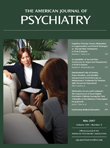Substantial Shared Genetic Influences on Schizophrenia and Event-Related Potentials
Abstract
Objective: Several components of event-related potentials—P50 suppression, P300 amplitude and latency, and mismatch negativity—have been proposed as potential endophenotypes for schizophrenia on the basis of family studies. The present study used a twin design to estimate the extent of genetic overlap between these indices and the liability to schizophrenia. Method: The authors measured mismatch negativity, P300, and P50 suppression in 16 monozygotic twin pairs concordant for schizophrenia, nine monozygotic twin pairs discordant for schizophrenia, and 78 healthy comparison twin pairs. The study design was based on a power calculation. Structural equation modeling was used to quantify the genetic and environmental contributions to the phenotypic covariance between schizophrenia and each of the event-related potential indices. Results: Significant phenotypic correlation with schizophrenia was found for each of the event-related potential components. Genetic factors were the main source of the phenotypic correlations. P50 suppression had the greatest genetic correlation with schizophrenia, followed by P300 amplitude, P300 latency, and mismatch negativity. Conclusions: All four event-related potential indices are potentially valid endophenotypes for schizophrenia, but P50 suppression and P300 amplitude show the closest genetic relationship to schizophrenia.



